With all the different acronyms flying around the SaaS marketing space, it’s hard to know which metric is a true “north star” whether it be an MQL, SQL, or something else.
Especially in the SaaS space, identifying which metric to align your marketing and sales goals is key to avoiding budget burn. Depending on which SaaS marketing strategy you choose to employ, your objectives may shift.
Which metric you end up choosing primarily depends on what point in the funnel you’re focusing on.
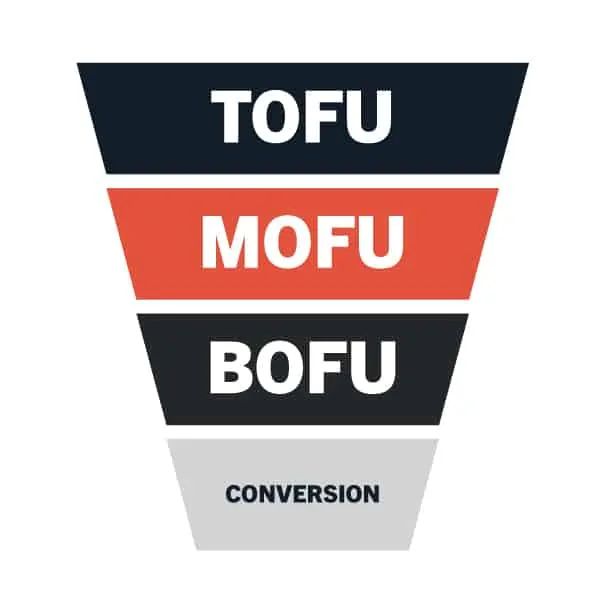
Focusing on the top of the funnel (TOFU) and generating demand for your software or service will often lead you towards MQLs – or marketing qualified leads.
On the other hand, focusing on the bottom of the funnel (BOFU) engagements like closing sales deals will lead you towards SQLs – or sales qualified leads.
While these aren’t the only metrics out there, they are the most reliable options of SaaS marketers today. And let’s be clear, choosing any random north star metric (NSM) to guide your growth campaigns is not an option. So understanding the difference between MQLs and SQLs is important if you want to make the right choice.
What Is An MQL (Marketing Qualified Lead)
By definition, a marketing qualified lead is a lead that is deemed as having a higher probability of turning into a customer. This assertion is usually based on the lead’s web behavior.

Some types of marketing behaviors that can qualify these prospects are:
- downloading content
- viewing landing pages
- signing up for a newsletter
- attending a virtual event
However, this is where the nuances of the SaaS space begin to become a problem. Because in the SaaS space you’re selling software and not a physical product, your consumers have far more opportunities to compare your brand against your competitors.
This is part of the cause behind the extended life cycle of the modern-day B2B SaaS buyer.
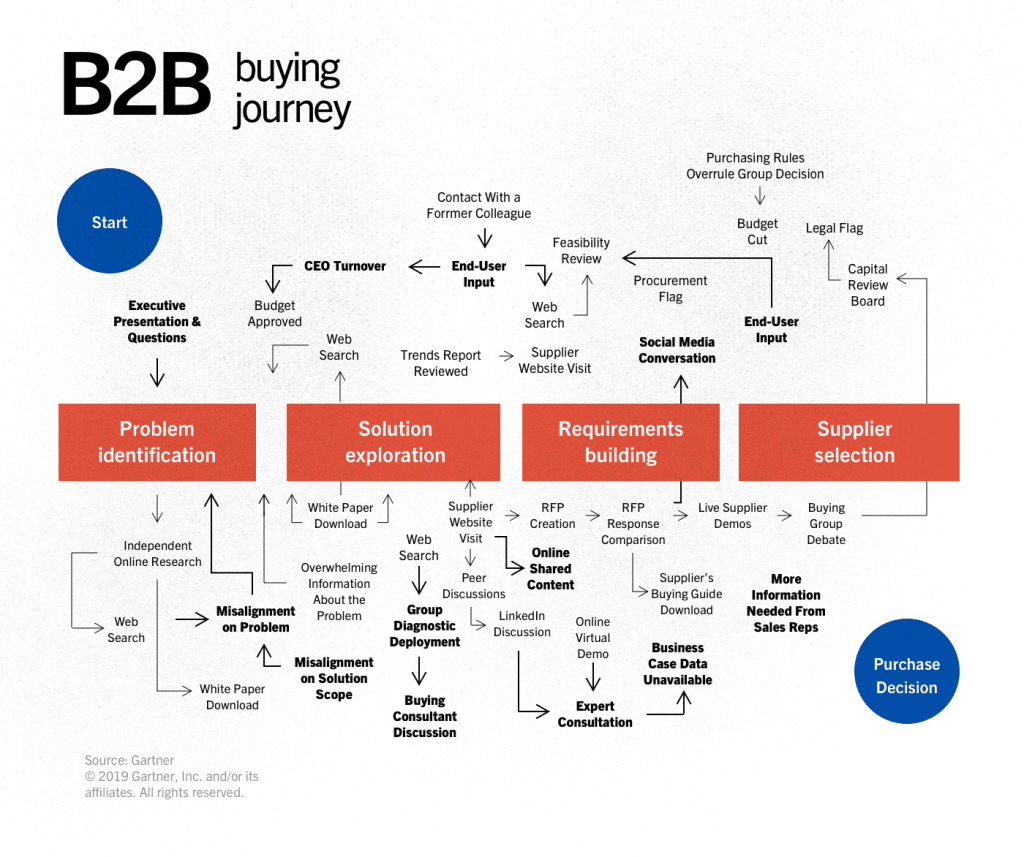
Yet another part of the problem that many people fail to account for is the discrepancy of actual end buyers in this already complicated journey.
Not only do you have to account for the messy and seemingly never-ending life cycle of your target SaaS account. You also have to consider the fact that the so-called “lead” you just converted isn’t even the end-buyer that your sales team needs to connect with.
“Go ahead and ask your sales team what they really think of an MQL that comes from downloading an eBook and whether or not they like those calls. The negative answers you receive should be enlightening.” – Garrett Mehrguth | Directive, CEO
What Is An SQL (Sales Qualified Lead)?
Now, unlike MQLs, the qualification process for SQLs typically happens on a call by a salesperson, instead of automatically via software. Similar to MQLs, the working definition of an SQL will vary from one company to the next. But in general an SQL is a prospect or lead that is ready to have a sales conversation about signing on the dotted line.

To ensure a seamless lead flow between the different stages, it’s imperative that both marketing and sales are aligned on what this definition is.
This goes beyond just sharing the same definition of an ICP (ideal customer profile).
Understanding how to qualify the transition from an MQL to an SQL can come down to many different criteria. But one popular lead qualification framework is called BANT, which stands for budget, authority, needs, and timeline.
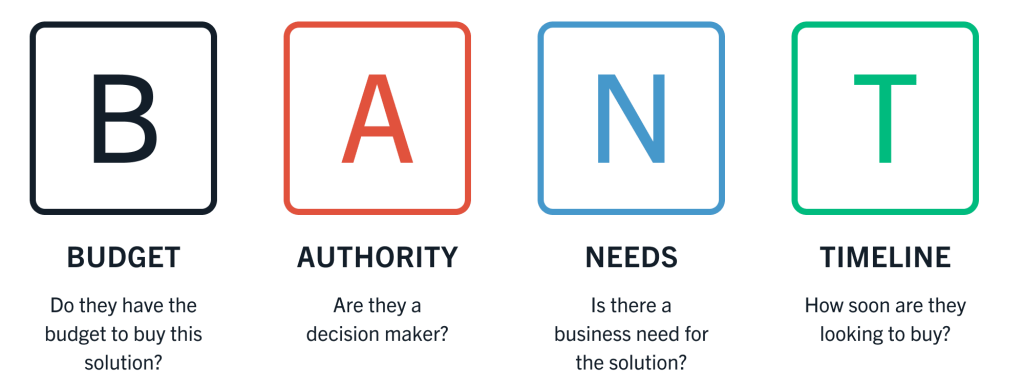
If you can properly align your brand’s service offerings towards your SQL’s BANT, you have a strong chance of closing that sale.
This is what distinguishes an SQL from the traditional MQL in value. While aligning your SaaS marketing efforts towards MQLs is a good start, it doesn’t translate to revenue consistently.
This is the main problem with MQLs. Because of their lack of direct correlation to revenue, you can often grow MQLs without actually growing your brand. Herein lies the fatal misalignment of most SaaS brands today.

Aligning your focus towards legitimately qualified sales opportunities is much closer to the mark. And isn’t that the point of a north star metric, after all?
The Differences Between MQL vs. SQL
The core difference between MQLs and SQLs boils down to how closely they correlate to the actual growth of your business. The truth is that, despite growing your MQL list you can still fail to grow revenue at the same pace. Why is this? Because the fact is that the Marketing Qualified Lead – when you really look at it – is not that “qualified” of a lead.
In the mind of an MQL focused marketing, you may see an increase in email signups and lead form submissions and think you’re flooding your sales team with gold. But, the reality looks a bit more like this:
The SDR has a handful of marketing qualified leads to follow up with each day. They go down the list and give each person a call. Some answer, most don’t. The next few days are spent following up and trying to get a hold of these people to schedule a qualifying intro call.
Out of the initial list of leads, the SDR only books calls with a few of them. Out of those few that do take a call, an even smaller number of them are ready to move forward in the sales process. From there, it’s highly unlikely that all of the leads who move forward will become customers.
The people that were unresponsive or uninterested can be placed in a marketing nurture sequence in the hopes of keeping them engaged enough to become SQLs down the line.
It may hurt to hear it, but the time of the MQL has come and gone. Vanity metrics such as these only play to the egos of marketers and lead to blind optimization and budget burn.
Why SQL Marketing Wins Over MQL
It’s time we move past the vanity metrics of both Demand and Lead Generation. Today’s SaaS buyers are educated, tech-savvy, scrutinizing buyers that you can’t afford to waste budget by sending useless follow-up emails or content promotions.
Think about it – when was the last time you were truly interested in a sales conversation after filling out an online form? Why do you think that the same old strategies will work on your audience instead?
It’s time we all evolve past the old tenants of B2B Demand Generation into the new age of SaaS marketing. Properly aligned strategies such as these that focus on SQL marketing and growing actual revenue fall under a new field of SaaS marketing.
We are now entering the era of Customer Generation.
Why SQL Marketing Is A Core Principle In Customer Generation
The SQL stands at the backbone of the most successful marketing strategies. Which is why it’s no surprise SQL marketing is so important to Customer Generation.
The beauty of the SQL, as opposed to its earlier-in-the-lifecycle counterpart, is that it can be leveraged in financial modeling. What exactly does this mean? It means that SQLs represent a consistent and scalable lever that grows revenue. You have an actual causal correlation to work with here, which gives you financial modeling and goal setting that much more powerful.
It also allows you to better allocate your marketing budget between unique campaigns. Understanding which campaigns are generating SQLs and revenue as opposed to disinterested MQLs makes pivoting budget that much easier.
It’s fair to say that knowing which lever to pull to consistently scale revenue and growth is the dream of every marketer. – Sean Thomas Martin | Directive, Marketing Manager.
What Is Customer Generation?
Customer Generation – as the name implies – is a marketing methodology that delivers on the promise that Demand Gen forgot about.
While demand generation strategies prioritize MQLs and then have you cross your fingers for an increase in revenue, Customer Generation aligns your marketing and sales, your NSMs, and your strategies towards what really matters: customers.
1,200+ Member SaaS Community
Core Principles Of Customer Generation
By realigning your strategies towards generating customers over clicks, you can start to see the growth and tangible attribution that most marketers only dream of. We know because we’ve done it ourselves.
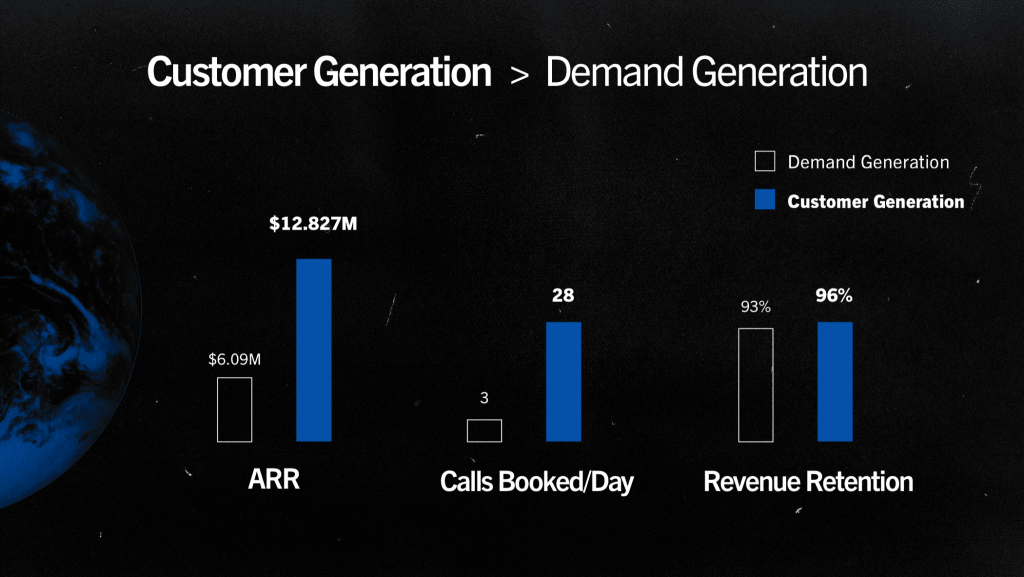
Let’s take a look at the core principles of Customer Generation and how it delivers on the promise Demand Gen forgot about. Here we’ll dive into how it exactly counters each of the five primary pain points of traditional SaaS marketing.
Customer-Led > Product-Led
Your product is not for the masses. The Customer-Led approach gives you the power to impact business KPIs such as: average contract value, trial conversion rate, lifetime value, customer acquisition cost, and more. By focusing on your most valuable customers, you’re in more control of what matters most – your actual end customer’s experience. Focusing on improving this end of the marketing interaction as opposed to forcing your new product on everyone generates obvious improvements.
Financial Modeling Is A Need to Have
Scaling without financial modeling is a pipe dream. Partnering with data architecture to identify your most impactful levers through your customer-led marketing ops team gives you the tools – and the confidence – to allocate more budget where you need it most.
SQLs Beat MQLs, Every Time
Let’s keep this one simple (if you haven’t got the point yet). MQLs are like balloons. When they inevitably pop, there’s nothing inside. Great marketing makes you money. No need for extrapolation here.
There’s No Such Thing As B2B
Your customers are people, not corporations. They hate inhumane marketing as much as you do, we promise. Hold yourself to a higher standard of crafting genuinely delightful customer experiences and see if your customers don’t respond.
Customer Generation (SQL) vs. Demand Generation (MQL)
Of course, demand generation still has its place in SaaS marketing. But it’s only a part of a much larger, holistic picture of the modern-day customer journey. And at the end of the day, we need to be looking at our marketing and sales efforts – as well as our chosen metrics – in terms of this larger picture.
It’s not email signups or lead submissions that pay your bills at the end of the day. Your lead list doesn’t pay the light bills. Your customers do.
Properly aligning your entire Growth Department towards the singular goal of generating customers is a great first step in terms of optimizing your demand gen strategies.
If you want to move beyond aimless efficiency, you can’t just optimize everyone for their individual performance. You need to make sure everyone is looking at the same goal as well.
If you want to drive actual growth towards business objectives, outcomes, and revenue, you need to ensure that your chosen methodology reflects that from the bottom up.
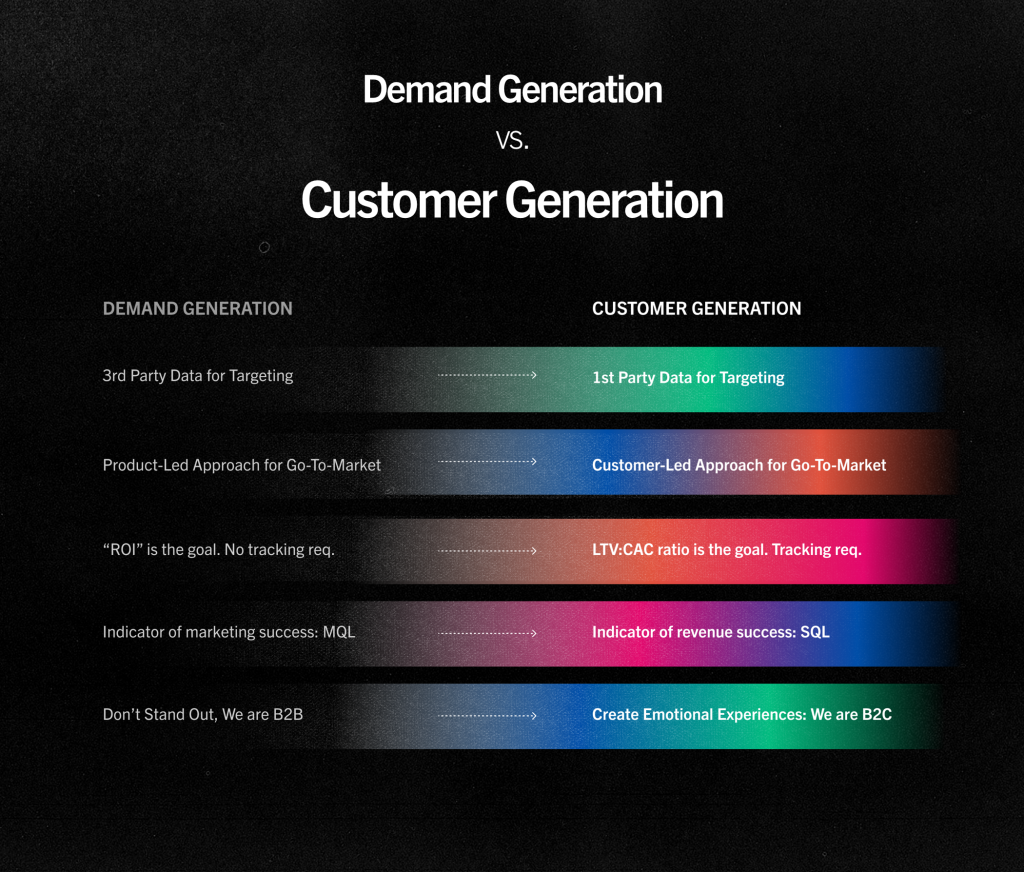
CTA
1,200+ Member SaaS Community